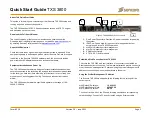
23
15 address groups are possible:
11, 12, 13, 14, 21, 22, 23, 24, 31, 32, 33, 34, 41, 42, 43
In order to be able to separately control each receiver, you need to program
each receiver to a single address. In addition to the address group that is
already selected (room A: 11, room B: 12, room C: 13, room D: 14), a
subaddress is also needed.
The following 15 subaddresses are possible for each address
group:
11, 12, 13, 14, 21, 22, 23, 24, 31, 32, 33, 34, 41, 42, 43
In the example the awning is programmed to the single address 1211,
which comprises the address group 12 and its subaddress 11.
All the receivers in room A have also been programmed to a local master
address (1144 in the example).
For the local master address 44 is always set as the subaddress,
while one of the 15 local master addresses (11, 12, 13, 14, 21,
22, 23, 24, 31, 32, 33, 34, 41, 42, 43) can be selected via the
address group.
Example:
1144, address group 11, subaddress 44
All the lamps in the house can be controlled via the global master address
4444.
The awning was deliberately not programmed to this address and can
therefore only be addressed via its single address (1211). It must be
operated separately in this example.
The ceiling lamps in all the rooms are also combined in a function group
(4411 in the example, address group 44, subaddress 11) and can therefore
be jointly controlled.
To select one of the 15 function groups, you need to set 44 as the address
group and a value between 11 and 43 (11, 12, 13, 14, 21, 22, 23, 24, 31, 32,
33, 34, 41, 42, 43) as the subaddress.










































